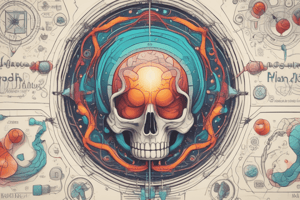Podcast
Questions and Answers
What is the primary indication for morphine sulfate?
What is the primary indication for morphine sulfate?
Which statement best characterizes hydromorphone (Dilaudid)?
Which statement best characterizes hydromorphone (Dilaudid)?
What potential effects should be assessed before starting analgesic therapy?
What potential effects should be assessed before starting analgesic therapy?
What is naloxone hydrochloride (Narcan®) primarily used for?
What is naloxone hydrochloride (Narcan®) primarily used for?
Signup and view all the answers
Which drug is known for having a ceiling effect and is often used as an antitussive?
Which drug is known for having a ceiling effect and is often used as an antitussive?
Signup and view all the answers
What should be included in a thorough pain assessment?
What should be included in a thorough pain assessment?
Signup and view all the answers
Which of the following is a distinguishing feature of opioids in comparison to non-opioid analgesics?
Which of the following is a distinguishing feature of opioids in comparison to non-opioid analgesics?
Signup and view all the answers
Which of these medications is classified as a synthetic opioid?
Which of these medications is classified as a synthetic opioid?
Signup and view all the answers
What is the mechanism of action for agonist opioid drugs?
What is the mechanism of action for agonist opioid drugs?
Signup and view all the answers
Which of the following opioids is not recommended for long-term use due to a neurotoxic metabolite?
Which of the following opioids is not recommended for long-term use due to a neurotoxic metabolite?
Signup and view all the answers
Which statement correctly distinguishes between opioid tolerance and psychological dependence?
Which statement correctly distinguishes between opioid tolerance and psychological dependence?
Signup and view all the answers
What is a common adverse effect associated with opioid analgesics?
What is a common adverse effect associated with opioid analgesics?
Signup and view all the answers
Which of the following terms describes the state of adaptation to chronic opioid treatment?
Which of the following terms describes the state of adaptation to chronic opioid treatment?
Signup and view all the answers
What is the primary purpose of opioids in a clinical setting?
What is the primary purpose of opioids in a clinical setting?
Signup and view all the answers
Which of the following conditions is a contraindication for opioid use?
Which of the following conditions is a contraindication for opioid use?
Signup and view all the answers
Which class of opioids causes a weaker pain response than full agonists?
Which class of opioids causes a weaker pain response than full agonists?
Signup and view all the answers
What distinguishes pain threshold from pain tolerance?
What distinguishes pain threshold from pain tolerance?
Signup and view all the answers
Which type of pain is characterized by a sudden onset and limited duration?
Which type of pain is characterized by a sudden onset and limited duration?
Signup and view all the answers
Which of the following is a nonpharmacological method for managing pain?
Which of the following is a nonpharmacological method for managing pain?
Signup and view all the answers
In the analgesic ladder, which medications are recommended for managing mild pain levels of 1-3?
In the analgesic ladder, which medications are recommended for managing mild pain levels of 1-3?
Signup and view all the answers
What is a significant characteristic of 'Step 1' medications in the analgesic ladder?
What is a significant characteristic of 'Step 1' medications in the analgesic ladder?
Signup and view all the answers
Which option correctly represents the difference between mu agonists and agonist-antagonists?
Which option correctly represents the difference between mu agonists and agonist-antagonists?
Signup and view all the answers
Which aspect does not influence pain tolerance among individuals?
Which aspect does not influence pain tolerance among individuals?
Signup and view all the answers
What is the minimum duration for classifying pain as persistent or chronic?
What is the minimum duration for classifying pain as persistent or chronic?
Signup and view all the answers
Study Notes
Pain
- Pain is an unpleasant sensory and emotional experience associated with actual or potential tissue damage.
- It's a personal and individual experience.
- Pain exists when the patient says it exists.
Nociception
- Pain results from stimulation of sensory nerve fibers called nociceptors.
- Nociceptors transmit pain signals from various body regions to the spinal cord and brain.
- Nociceptive pain includes somatic and visceral pain.
Pain Threshold vs. Tolerance
- Threshold: Level of stimulus needed to produce the perception of pain. A measure of the physiological response of the nervous system.
- Tolerance: The amount of pain a person can endure without it interfering with normal function.
- Tolerance varies from person to person, and is subjective, not a physiological function. It varies by attitude, personality, environment, culture, and ethnicity.
Classification of Pain by Onset and Duration
- Acute Pain: Sudden onset, limited duration, has an end.
- Persistent Pain (Chronic Pain): Persistent or recurring, lasts 3 to 6 months, more difficult to treat.
Nonpharmacological Therapy for Pain
- Cold Application: Reduce dose of analgesic required and minimize adverse effects. Possibly altering ascending nociceptive input or stimulating descending pain modulation mechanisms.
- Cognitive Techniques: Application of cold or heat.
- Massage: Relaxation strategies, cognitive techniques, distraction, self-management.
- Exercise: Massage, exercise, transcutaneous electrical nerve stimulation (TENS), and heat therapy.
- Relaxation Techniques: Relaxation strategies, distraction, cognitive techniques, self-management.
- Self-management: Relaxation strategies, self-management, distraction, cognitive techniques.
Three-Step Analgesic Ladder
- A tiered system for pain management, starting with nonopioid analgesics for mild pain, progressing to opioids for moderate-severe pain, and potentially other adjuvants as needed. (Diagram showing steps)
Medication Therapy for Pain: Analgesic Ladder
- Step 1: Mild pain (1-3 on a scale of 0-10), Nonopioid analgesics (aspirin, other salicylates, NSAIDs, acetaminophen(Tylenol)). Has a ceiling effect. No tolerance or physical dependence. Available without prescription.
- Step 2: Mild to moderate pain (4-6 on a scale of 0-10) or mild but persistent despite nonopioid therapy. Opioid agonists (morphine, oxycodone, hydromorphone, methadone).
- Step 3: Moderate to severe pain (4-10 on a scale of 0-10), or when Step 2 medications don't work. Potent mu-receptor agonists. No analgesic ceiling. Can be delivered via various routes.
Nonopioid Analgesics: Acetaminophen (Tylenol)
- Analgesic and antipyretic effects
- Little to no anti-inflammatory effects.
- Available over-the-counter (OTC) and in combination products with opioids.
Acetaminophen: Mechanism of Action
- Similar to salicylates, blocks pain impulses peripherally by inhibiting prostaglandin synthesis.
- Indications: mild to moderate pain, fever, inability to take aspirin products.
Acetaminophen: Dosage
- Maximum daily dose for healthy adults is 4 g/day.
- Be aware of the acetaminophen content of all medications taken by the patient (OTC and prescription). Inadvertent excessive doses can occur when different combination drug products are taken together; be aware of combination products.
Acetaminophen: Contraindications and Interactions
-
Avoid use in drug allergies, liver dysfunction, or possible liver failure.
-
Dangerous interactions with alcohol or other hepatotoxic drugs.
Acetaminophen: Toxicity and Managing Overdose
- Even available OTC, lethal when overdosed.
- Chronic misuse or intentional overdose leads to hepatotoxicity: hepatic necrosis. Long-term ingestion of high doses also causes nephropathy. An antidote regimen should be considered: Acetylcysteine.
Opioid Drugs
- Synthetic drugs binding to opiate receptors to relieve pain.
- Mild agonists (codeine, hydrocodone)
- Strong agonists (morphine, hydromorphone, hydrchloride, oxycodone, meperidine, fentanyl, methadone). Meperidine is not for long term use due to buildup of a toxic metabolite.
Opioid Analgesics: Mechanism of Action
- Agonists: Bind to opioid pain receptors in the brain, causing an analgesic response (reducing pain sensation).
- Agonists-antagonists: Bind to pain receptors to cause a weaker pain response than full agonists.
- Antagonists: Do not cause pain relief.
Opioid Analgesics: Indications
- Used to relieve moderate to severe pain, often in post-operative settings.
- Adjunct analgesic drugs assist primary drugs in pain relief.
- Opioids also used in cough suppression and diarrhea treatment.
Opioid Analgesics: Contraindications
- Known drug allergy
- Severe asthma
- Respiratory insufficiency
- Elevated intracranial pressure
- Morbid obesity or sleep apnea
- Paralytic ileus
- Pregnancy.
Opioid Analgesics: Adverse Effects
- CNS depression (leads to respiratory depression; most serious adverse effect)
- Nausea, vomiting, constipation, biliary tract spasm, urinary retention, hypotension, palpitations, flushing
- Itching, rash, wheal formation
- Pinpoint pupils (possible overdose)
Opioids: Opioid Tolerance
- Physiological adaptation to chronic opioid use.
- Larger doses needed for the same level of analgesia.
Opioids: Physical Dependence
- Physiological adaptation to opioids.
- Expected with long-term use.
- Not the same as psychological dependence (addiction).
Opioids: Psychological Dependence
- Compulsive drug use, characterized by a craving and need for opioids for effects other than pain relief.
Opioid Analgesics: Interactions
- Alcohol
- Antihistamines
- Barbiturates
- Benzodiazepines
- Promethazine
- Monoamine oxidase inhibitors
- Other drugs
Codeine Sulfate
- Natural opiate alkaloid (schedule I), obtained from opium.
- Less effective than other opioids; primarily an antitussive drug.
- Has a ceiling effect. Gastrointestinal disturbance.
Morphine Sulfate
- Naturally occurring alkaloid derived from the opium poppy.
- Drug prototype for all opioid drugs; schedule I controlled substance.
- Oral, injectable, rectal, and extended-release forms
- Indication: severe pain
Dilaudid
- Hydromorphone (Dilaudid®): very potent opioid analgesic (schedule I).
- 1 mg IV/IM hydromorphone equivalent to 7 mg morphine.
Naloxone Hydrochloride (Narcan®)
- Pure opioid antagonist.
- Drug of choice for complete/partial reversal of opioid-induced respiratory depression. Used in cases of suspected acute opioid overdose.
Analgesics: Nursing Implications
- Thorough history (allergies, other medications, alcohol, medical history).
- Baseline vital signs (intake/output/respiratory rate).
- Assess for contraindications/drug interactions.
- Pain assessment (intensity, character, onset, location, description, precipitants, relievers, treatment).
- Pain is considered a fifth vital sign, rated on a 0–10 or similar scale.
- Mediate before pain becomes severe.
- Include pharmacological & nonpharmacological pain management approaches.
- Instruct patients to avoid other meds/OTCs without checking with physician.
- Notify physician of any allergic reactions/adverse effects.
Opioid Analgesics: Nursing Implications
- Monitor for therapeutic effects (decreased pain perception/ severity, increased comfort, Improved ADLs, appetite, sense of well-being, decreased fever (with acetaminophen)).
Anaesthetics
- Drugs reducing or eliminating pain by depressing nerve function in CNS and peripheral nervous system.
- General anesthesia: complete loss of consciousness (and loss of body reflexes including respiratory muscles). Local anesthesia removes pain sensation, but not consciousness.
General Anaesthetics
- Drugs inducing altered CNS states, typically for pain relief, depression of consciousness, muscle relaxation, and reduced reflexes.
- Inhalational anaesthetics - volatile liquids or gases vaporized in oxygen and inhaled.
- Parenteral anaesthetics - administered intravenously.
- Adjunct anaesthetics - utilized with other drugs for enhanced therapy. - Balanced anaesthesia - use of multiple drugs simultaneously.
Mechanism of Action of General Anaesthetics
- Potency directly correlated with lipid solubility of drugs. Fat-soluble stronger than water-soluble drugs; nerve cell membranes and the blood-brain barrier are high in fat content. Lipid-soluble anaesthetic drugs can cross the blood-brain barrier easily to concentrate in nerve cells, therefore providing an effect. The actions result orderly and systematically in regards to the CNS functions in regard to sensation and movement. A progressive depression will occur in the cerebral and spinal nervous functions.
General Anaesthetics: Indications
- Used in surgical procedures for unconsciousness, skeletal muscle relaxation, and visceral smooth muscle relaxation.
- Used in electroconvulsive therapy (ECT).
General Anaesthetics: Adverse Effects
- Adverse effects vary according to dosage and drug used (heart, peripheral circulation, liver, kidneys, respiratory tract.
- Myocardial depression is often seen.
General Anaesthetics: Adverse Effects
- Malignant hyperthermia: occurs during or after general anaesthesia using volatile inhaled agents or neuromuscular blocking drugs (such as succinylcholine), sudden and significant elevation in body temperature, tachypnea, tachycardia, muscle rigidity; is a life-threatening emergency and is treated with cardiorespiratory supportive care and dantrolene sodium.
- Toxicity and overdose management: Large doses can be potentially life-threatening. Causes of death include cardiac and respiratory arrest. Administer in a controlled setting. Interaction concerns: antihypertensives and beta-blockers.
Ketamine Hydrochloride
- Intravenous administration for both general anesthesia and moderate sedation. Rapid onset. Low incidence of reduction in cardiovascular, respiratory, and bowel function. Adverse effects: disturbing psychomimetic effects, including hallucinations. Contraindicated with known drug allergies.
Nitrous Oxide (Laughing Gas)
- Inhaled gas used as a general anesthetic. Weakest of general anesthetic drugs. Primarily used in dental procedures or supplemental anesthetic.
Propofol (Diprivan)
- Parenteral general anesthetic, used for induction and maintenance of general anesthesia. Lower doses for moderate sedation; mechanical ventilation in CCU. Caution for hemodynamically unstable patients.
Sevoflurane
- Fluorinated ether, widely used. Rapid onset and rapid elimination; especially useful in outpatient surgical settings. Nonirritating to the airway; greatly facilitates induction of unconsciousness, particularly in pediatric patients.
Procedural Sedation
- Also called conscious/moderate sedation
- Does not cause complete loss of consciousness and does not often cause respiratory arrest.
- Combination of an IV benzodiazepine (midazolam) or propofol and an opiate analgesic (fentanyl or morphine)
- Propofol also commonly used. Reduces anxiety and pain sensitivity; patient cannot recall procedure.
Local Anaesthetics
- Also called regional anaesthetics. Aims to render a specific body part, not the entire body, insensitive to pain. Interferes with nerve impulse transmission. Not consciousness-altering.
- Topical: Applied directly to skin/mucous membranes (creams, solutions ointments, gels, ophthalmic drops, powders, suppositories)
- Parenteral: Injected intravenously or into CNS via various spinal injection techniques
Types of Local Anesthesia
- Spinal/intraspinal
- Intrathecal
- Epidural
- Infiltration
- Nerve block
- Topical
- Peripheral nerve catheter attached to pump containing local anesthetic, (e.g ON-Q PainBuster® pump)
Types of Local Anesthesia: Specific Drugs
- Benzocaine
- Cocaine hydrochloride
- Dibucaine hydrochloride
- Lidocaine
- Prilocaine
- Tetracaine hydrochloride
Drug Effects: Paralysis
- Autonomic activity first, followed by pain and other sensory functions, and lastly, motor activity is lost as the local anesthetic wears off. Recovery from local anesthetic effects occurs in reverse order (motor, then sensory, then autonomic activity is restored).
Adverse Effects
- Usually limited. Adverse effects if: inadvertent intravascular injection, excessive dose/rate of injection, slow metabolism, injection into highly vascular tissue. Spinal headache. 70% of patients who experience inadvertent dural puncture will have spinal headache; often self-limiting. Treatment: bed rest, analgesics, caffeine, blood patch.
Neuromuscular Blocking Drugs (NMBDs)
- Prevent nerve transmission in skeletal & smooth muscle, resulting in muscle paralysis.
- Used with anesthetics during surgery and are required for artificial ventilation of these patients.
- The drugs paralyze respiratory/skeletal muscles. May also cause a loss of consciousness or pain relief. Do not use as a pain reliever.
- NMBDs result in muscle weakness then paralysis. Recovery occurs in reverse order.
Neuromuscular Blocking Drugs (NMBDs): Depolarizing Drugs
- Work similarly to the neurotransmitter acetylcholine (ACh), causing depolarization.
- Metabolism is slower than acetylcholine, so repolarization cannot occur while the drug is present.
- Result: flaccid muscle paralysis (succinylcholine - Quelicin)
Neuromuscular Blocking Drugs (NMBDs): Nondepolarizing Drugs
- Long-acting non-depolarizing agents such as pancuronium bromide.
- Used for general anesthesia as an adjunct, to facilitate endotracheal intubation, and provide skeletal muscle relaxation during surgery.
- Used for long procedures requiring prolonged muscle paralysis. Injectable only.
Neuromuscular Blocking Drugs: Safety
- Respiratory muscle paralysis occurs with these drugs.
- Emergency ventilation equipment must be immediately available.
Studying That Suits You
Use AI to generate personalized quizzes and flashcards to suit your learning preferences.
Related Documents
Description
This quiz covers key concepts related to opioid analgesics, including indications, mechanisms of action, and patient assessment prior to analgesic therapy. Test your understanding of various opioid medications and their effects on patients, including adverse effects and potential for tolerance or dependence.




